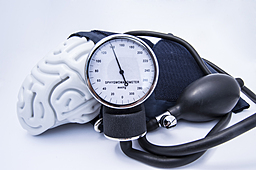Intracranial Pressure Monitor Enhancement for Cerebral Hemodynamic Monitoring
TECHNOLOGY NUMBER: 2018-471

OVERVIEW
Cerebral Blood Flow Monitor for Continuous, Real-time Monitoring of Traumatic Brain Injury (TBI)- Augmented ICP device for cerebral hemodynamic monitoring
- Calculates and displays instantaneous blood flow and cerebral autoregulation
BACKGROUND
Traumatic and other brain injuries are often followed by secondary ischemic damage to the brain that results from decreased blood flow. As high intracranial pressure (ICP) is often the cause of the decreased blood flow, ventriculostomy catheters and intraparenchymal monitors have been employed to measure ICP. However, there are no reliable methods for directly monitoring cerebral blood flow, cerebral vascular resistance, or cerebral autoregulation available for use in traumatic brain injury (TBI) management. Methods to measure cerebral blood flow proposed in research rely on imaging and are inadequate as they can only provide information intermittently and infrequently. Furthermore, these approaches lack the sensitivity and dynamic readouts that allow physicians to make appropriate and rapid treatment decisions when time is the most critical factor for improving prognosis. There is a substantial unmet medical need for continuous monitoring of ICP and blood flow, cerebral vascular resistance, and cerebral autoregulation using technologies that can be easily adapted and used in the critical care clinical setting.
INNOVATION
Researchers have created a device that performs cerebral hemodynamic monitoring in real time. This outcome is achieved by an assembly comprised of a piezoelectric thick-film and fiber optic attachment that can be added to existing ventriculostomy catheters or intraparenchymal monitors so as to enable continuous monitoring of cerebral blood flow, cerebral vascular resistance, and cerebral autoregulation. The sensor is encapsulated in biocompatible materials and only adds approximately 50-200 micrometers to the diameter of catheters which are presently being used for ICP monitoring. Electrical and optical readouts are integrated to calculate and display instantaneous blood flow and cerebral autoregulation from the measured parameters. Sensing and flow estimates can permit clinicians to determine whether cerebral blood flow is increasing, stable, or decreasing, and also if cerebral autoregulation is intact in response to interventions or as the body's response to brain injury progresses. Additional features may include fiberoptic delivery of spectroscopic technologies, allowing for the monitoring of oxygenation and metabolites.